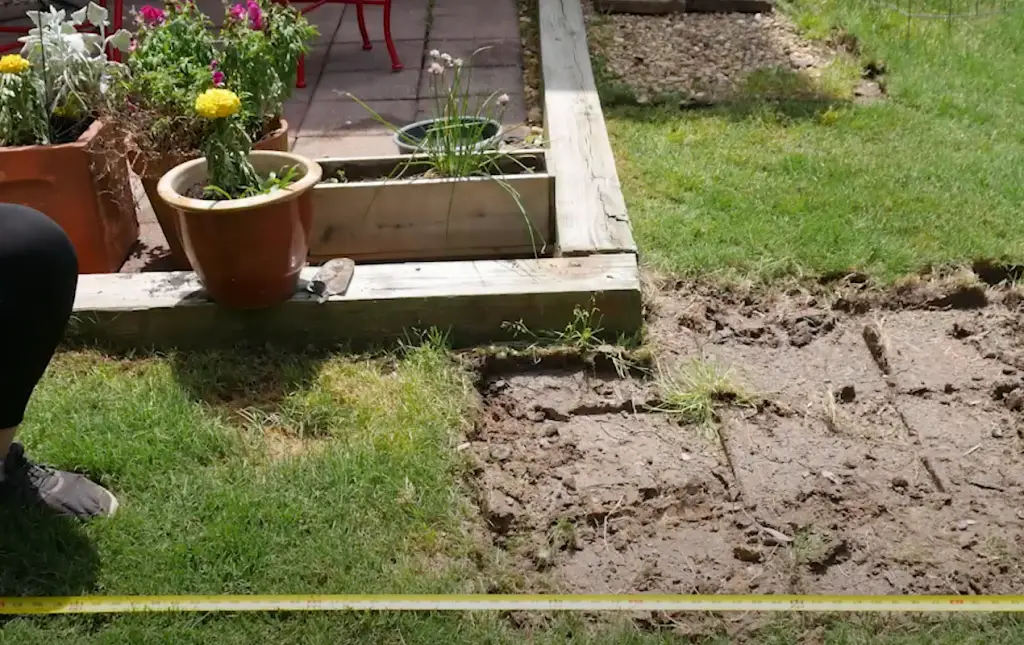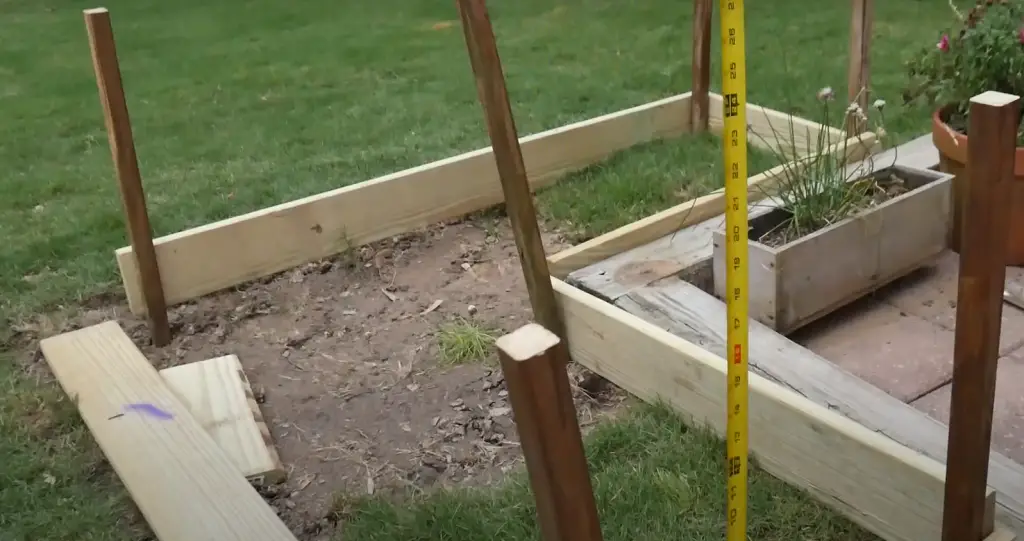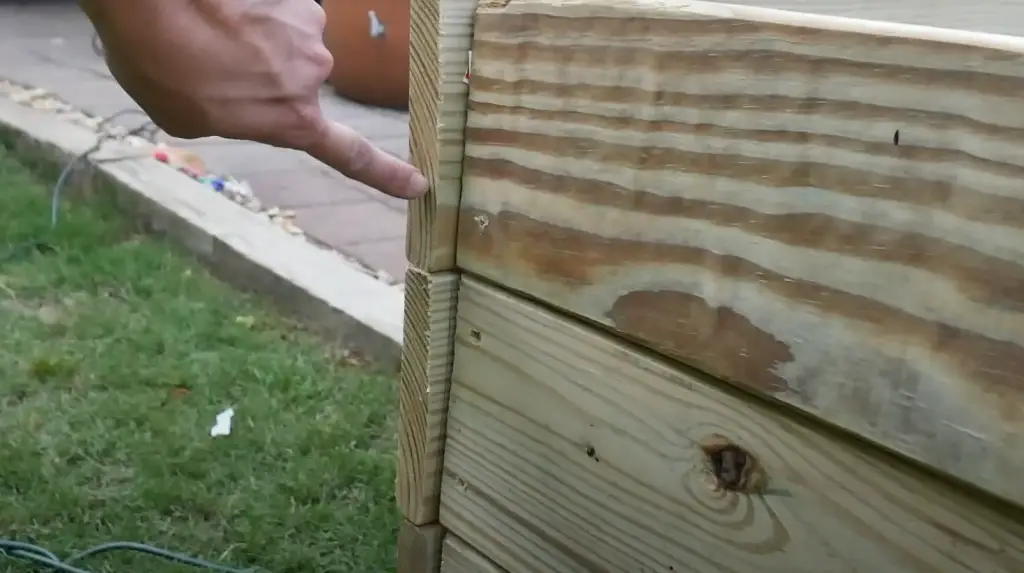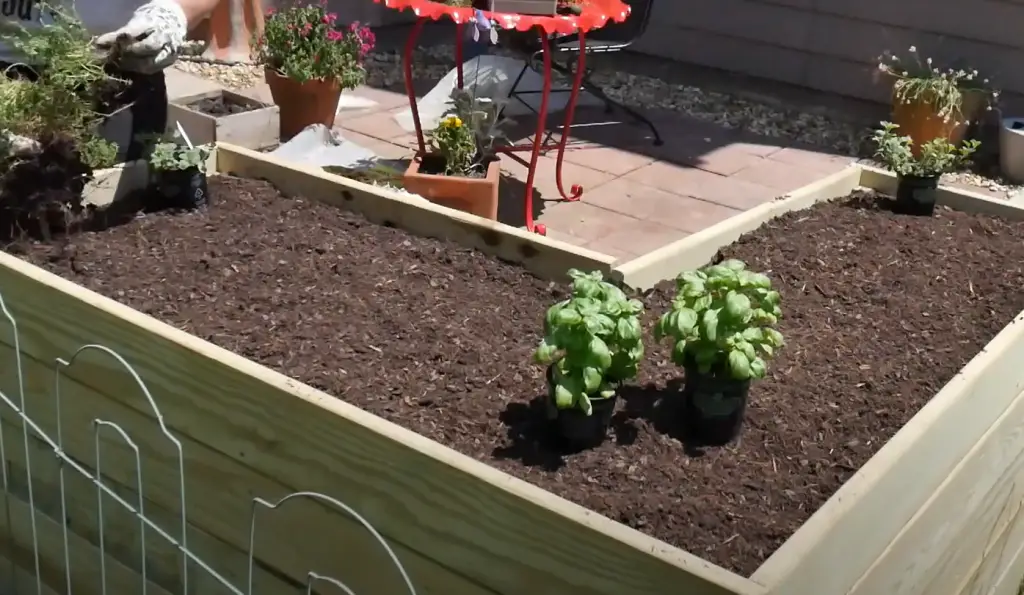Gardeners across the country are increasingly turning to pressure-treated wood for building garden beds. With its unique qualities, this type of wood can provide many benefits over other materials such as durability and low cost, making it an attractive choice for building raised garden beds. But how safe is pressure-treated wood for growing vegetables or flowers? This blog post will answer all your questions about using pressure-treated wood for building garden beds and discuss the advantages and disadvantages it offers.
What is Pressure-Treated Wood?
Pressure-treated wood is wood that has been infused with chemical preservatives to protect it from rot, decay, and insect damage. Pressure-treated wood can be used for decks, fences, playground equipment, outdoor structures such as gazebos and pergolas, and other outdoor applications. The process of pressure-treating the wood helps it last longer than untreated wood would in similar conditions.

It’s important to note that when pressure-treating wood, it should be done by an experienced professional who uses a specialized machine to ensure proper coverage of the chemicals throughout the entire piece of lumber. This ensures that the protection is evenly applied throughout the project. The specific type of preservative used may vary based on the type of application and environment.
In addition to protection from rot, decay, and insects, pressure-treated wood also offers improved fire resistance compared to untreated wood. This makes it a good choice for outdoor projects located in areas with high fire risk.
When working with pressure-treated wood, it is important to wear protective gear such as gloves, eye protection, and a dust mask to protect yourself from any chemicals used during the treatment process. It’s also important to keep treated wood away from direct contact with food or potable water sources as some of the chemicals used can be toxic if ingested.
Finally, make sure you follow all directions when installing any products made of pressure-treated wood, including sealing the wood and making sure it’s properly supported. This will help ensure the safety of your family and extend the life of your project.
Pressure-treated wood is a great choice for outdoor projects, but only when used correctly and safely. Make sure to follow all instructions and wear protective gear when working with pressure-treated lumber. Doing so will help keep you safe, prolong the life of your project, and give you years of use and enjoyment from your outdoor space [1].
What Is CCA – Treated Wood?
CCA-treated wood is pressure-treated lumber that has been treated with chromated copper arsenate (CCA). This chemical treatment helps to protect the wood from decay, rot, and insects. CCA-treated wood is used in a variety of outdoor projects such as decks, fences, picnic tables, play sets, and other outdoor structures. While it’s easy to work with and long-lasting, CCA-treated wood does contain arsenic which can be toxic if ingested or inhaled. Therefore, it’s important to take certain precautions when working with this type of treated lumber. Some states have even banned the use of CCA for residential use due to its potential health hazards.
Additionally, you should always dispose of sawdust and scrap pieces in sealed plastic bags so that children and pets are unable to access them. It’s also important to wash your hands after working with CCA-treated wood.
With proper safety precautions in place, CCA-treated wood is a great option for outdoor structures that will be exposed to the elements. It can protect from decay and insect damage for many years if properly maintained. However, it’s important to remember that CCA-treated wood does contain arsenic which can be dangerous if ingested or inhaled without taking proper safety precautions first. Therefore, it’s best to take the necessary safety precautions when working with this type of treated wood.
What Are The Benefits Of CCA-Treated Wood?
CCA-treated wood is a great option for outdoor projects because of its long-lasting protection against rot and insect damage. It also stands up well to harsh weather conditions such as extreme cold and extreme heat. Additionally, CCA-treated wood is easy to work with and relatively inexpensive compared to other types of treated lumber. Lastly, CCA-treated wood can help protect your home from potential fire hazards due to its low flammability rating.
Overall, CCA-treated wood is an excellent choice for outdoor projects that need protection from the elements. It’s long-lasting, relatively inexpensive, and easy to work with. However, it is important to remember that CCA-treated wood does contain arsenic which can be dangerous if not handled properly. Therefore, it’s best to take all necessary safety precautions when working with this type of treated lumber.
What are the best types of garden beds?
The best types of garden beds depend on your individual needs and preferences. In general, raised beds are a great option because they provide good drainage and keep weeds away. Raised beds can be made from wood, stone, or other materials. They come in various shapes and sizes, so you can easily find one that works for your garden. Additionally, using containers can also be a great way to create beautiful gardens with limited space.

Containers allow you to select the type of soil mix that works best for your plants and make it easy to move them around when necessary.
Finally, don’t forget about vertical gardens, which are great for small spaces and require minimal maintenance.No matter what type of garden bed you choose, it’s important to make sure you create one that’s suitable for the type of plants you’re growing. Additionally, it’s important to consider drainage, soil quality, sun exposure, and other factors when designing your garden beds. With some careful planning and a bit of creativity, you can create beautiful, functional garden beds that will last for years to come [2].
How Do You Know If Your Wood Is CCA Treated?
End Tags
Before purchasing wood, it is important to know if the wood has been pressure treated with CCA. You can tell if a piece of wood is CCA-treated by looking for stamping or labeling on the end tags.
The end tags will list the type of treatment that was used, along with other information such as the concentration of chemicals in the solution and which company applied the treatment.
The Stamps
The stamps found on CCA-treated lumber are typically triangular, with “CCA” written on them. Some may also have the initials of the treating company, such as “MPN” for MicroPro (formerly ProWood). Additionally, certain manufacturers may use a stamp that indicates the specific concentration of chemicals used in their treatment process.
Check the Colour
The color of the wood can also help identify CCA-treated lumber. Pressure-treated wood tends to have a greenish hue, which may be more or less pronounced depending on the concentration of chemicals used in the treatment process.
Testing for Chemicals
If you are unsure if your wood is pressure treated, you can always have it tested for chemical residue. This should be done by a professional, such as an environmental testing firm or a laboratory accredited by the Environmental Protection Agency (EPA). The testing results will indicate whether there are any traces of CCA left in the wood [3].
Conduct a Smell Test
Finally, you can also conduct a smell test to determine if your wood is pressure treated. Pressure-treated wood has a distinct odor, and the strength of this odor will depend on the amount of chemicals used in the treatment process.

If you notice any strange smells coming from your wood, it could be an indication that it has been treated with CCA.
Best Woods for Raised Garden Beds
Raised garden beds are an excellent way to make gardening easier and more efficient. With proper construction and materials, they can last for many years with minimal maintenance. One of the most important decisions when building a raised garden bed is the type of wood you will use. Here are some of the best woods for raised garden beds:
- Cedar – Cedar is a very popular choice for outdoor projects like raised garden beds because it’s naturally resistant to decay and rot. It also has an attractive grain pattern and natural oils that protect it from pests. Cedar is also lightweight, making it easy to build with.
- Redwood – Redwood is another great option for raised garden beds thanks to its natural resistance to rot and decay. It’s also very strong and has a beautiful grain pattern. Redwood is slightly more expensive than cedar, but its long-term durability makes it worth the extra cost.
- Pine – Pine is a great choice for raised garden beds because it’s relatively inexpensive and easy to work with. It’s not as durable as cedar or redwood, so you may want to consider treating it with a preservative if you use pine in your raised garden bed.
- Teak – Teak is one of the most expensive woods on this list, but it’s also one of the best options for outdoor projects like raised garden beds because it’s naturally resistant to rot and decay. It’s also highly durable and has a beautiful grain pattern that adds to its aesthetic appeal.
- Cypress – Cypress is a great choice for raised garden beds because it’s naturally resistant to rot and insects. It also has an attractive grain pattern that looks great in outdoor projects like raised garden beds. Additionally, cypress is fairly inexpensive, making it a cost-effective option for your project.
No matter which type of wood you choose for your raised garden bed, make sure it’s been treated with a preservative or sealant to protect it from the elements. This will help ensure that your raised garden bed lasts for many years to come [4].
Can You Use Pressure Treated Wood for Garden Beds?
The short answer is yes, you can use pressure-treated wood for garden beds. However, there are a few precautions to take when using pressure-treated wood in raised bed gardens.
Pressure-treated wood is treated with an array of chemicals and preservatives that make the wood resistant to rot and insect infestations.
To reduce potential impacts on plant health, paint or seal the outside of your raised bed structures to minimize contact between the soil and any untreated surfaces of the pressure-treated lumber.When selecting woods for raised beds, consider alternatives such as naturally rot-resistant species like cedar or redwood, which are naturally more expensive than pressure-treated lumber. If you select pressure-treated wood for raised beds, use only “ground contact” treated wood, and use it only in parts of the garden that will not come into direct contact with edible plants.

Finally, to protect soil health and plant life from potential contamination from chemicals used to treat the wood, line your raised bed with a plastic liner before filling it with soil or compost. This can help prevent any chemical leaching into the garden soil that could potentially harm your plants.
How to maintain garden beds?
Regular maintenance is an important part of keeping raised beds in good condition and ensuring the health and productivity of your garden. Here are a few tips for maintaining your raised beds:
- Keep them free from weeds by monitoring and hand-weeding regularly.
- Check soil moisture weekly to ensure your plants have enough water.
- Add compost or aged manure to replenish nutrients in the soil.
- Regularly check for signs of pests or disease, and take action if necessary.
- Prune plants as needed to maintain healthy growth.
- Give plants space by thinning crowded areas when necessary.
- Protect wood structures with paint or sealant every three years or so.
By taking the time to maintain your garden beds, you can ensure that they remain healthy and productive for years to come.
FAQ
Is pressure-treated wood safe for raised gardens?
Pressure-treated wood is safe for raised gardens when it has been treated with a preservative that contains copper, chromium, and arsenic (CCA). The CCA treatment prevents the wood from rotting and resists insect infestations. However, it is important to note that the soil in contact with pressure-treated wood may contain elevated levels of these chemicals. It is recommended to line the inside of your raised garden bed with plastic sheeting or use a non-pressure-treated material such as cedar or redwood for the frame. Additionally, using gloves when handling pressure-treated wood and washing hands after contact are other precautions you can take to reduce potential exposure.
Are there any alternatives to using pressure-treated lumber?
Yes, there are several alternatives to using pressure-treated lumber. Non-pressure-treated materials such as cedar or redwood can be used for raised garden beds due to their natural resistance to rot and insect infestations.

Composite wood materials and plastic sheeting are other options that may provide a safer alternative for raised gardens. Additionally, recycled materials such as old pallets or shipping crates can also be repurposed into raised beds with proper cleaning and sealing. For optimal safety, it is recommended to avoid using pressure-treated wood in your raised garden bed if possible.
Are there any special considerations when building with treated wood?
Yes, there are some special considerations to keep in mind when working with treated wood. Pressure-treated wood may contain chemicals such as copper, chromium, and arsenic (CCA). When handling pressure-treated wood, it is recommended to wear gloves and wash hands after contact. Additionally, the soil in contact with pressure-treated wood may contain elevated levels of these chemicals so it is important to avoid using treated wood directly against the soil. It is also advisable to line the inside of your raised garden bed with plastic sheeting or use a non-pressure-treated material such as cedar or redwood for the frame. Following these precautions can help reduce potential exposure and ensure the safe use of pressure-treated lumber for raised gardens.
Can you use pressure-treated lumber for raised vegetable beds?
Yes, pressure-treated wood can be used for raised vegetable beds when it has been treated with a preservative that contains copper, chromium, and arsenic (CCA). The CCA treatment prevents the wood from rotting and resists insect infestations. However, it is important to note that the soil in contact with pressure-treated wood may contain elevated levels of these chemicals.
It is recommended to line the inside of your raised garden bed with plastic sheeting or use a non-pressure-treated material such as cedar or redwood for the frame. Additionally, using gloves when handling pressure-treated wood and washing hands after contact are other precautions you can take to reduce potential exposure.
Are there any restrictions on using pressure-treated lumber for raised beds?
Yes, there are restrictions on using pressure-treated lumber for raised beds. Pressure-treated wood should not come in direct contact with edible plants or food crops as the chemicals in the wood may leach into the soil and contaminate the food grown in it. Additionally, pressure-treated wood should only be used when treated with approved preservatives that contain copper, chromium, and arsenic (CCA). For optimal safety, it is recommended to avoid using pressure-treated wood in your raised garden bed if possible.
How long will pressure-treated wood last in raised beds?
The lifespan of pressure-treated wood in raised beds will depend on a few factors, such as the type of preservative used and how it is treated. While some types of pressure-treated wood may last for up to 20 years, others may experience deterioration much sooner due to weathering or insect infestations. Additionally, soil contact with treated lumber can also cause accelerated decay so it is important to line the inside of your raised garden bed with plastic sheeting or use a non-pressure-treated material such as cedar or redwood for the frame. Properly maintaining and treating your pressure-treated lumber can ensure its longevity in raised beds.
Can I use pressure-treated wood for a bed?
Yes, pressure-treated wood can be used for a bed frame. However, it is important to note that the CCA treatment prevents the wood from rotting and resists insect infestations but may contain chemicals such as copper, chromium, and arsenic. To reduce potential exposure, it is recommended to line the inside of your bed frame with plastic sheeting or use a non-pressure-treated material such as cedar or redwood. Additionally, wearing gloves when handling pressure-treated wood and washing hands after contact are other precautions you can take to reduce potential exposure. The lifespan of pressure-treated wood in raised beds will depend on a few factors such as the type of preservative used and how it is treated.
What type of wood should I use for a raised garden bed?
For raised garden beds, it is best to use a non-pressure-treated material such as cedar or redwood. These types of wood are naturally resistant to rot and insect infestations and do not contain chemicals like copper, chromium, and arsenic. Additionally, if the cost of cedar or redwood exceeds your budget you can opt for pressure-treated wood that contains an approved preservative with copper, chromium, and arsenic (CCA). However, be sure to line the inside of your raised garden bed with plastic sheeting or use another non-pressure-treated material for the frame in order to reduce potential exposure.
What wood treatment is safe for gardens?
Wood treatments safe for gardens include natural preservatives such as boiled linseed oil, tung oil, and citrus-based products. These types of wood treatments are free from harsh chemical compounds that may leach into the soil and contaminate edible plants or food crops. Additionally, beeswax is also a safe option to protect wood against rot and water damage in garden settings. It is important to read labels carefully when selecting a wood treatment for your raised garden bed and ensure that it does not contain any chemicals that could potentially be harmful to plants or animals. Choosing the right type of wood treatment can help ensure your outdoor space remains beautiful and healthy year-round.
What is the safest material for raised garden beds?
The safest material for raised garden beds is a non-pressure-treated wood such as cedar or redwood. These types of wood are naturally resistant to rot and insect infestations and do not contain any harsh chemicals that could potentially leach into the soil and contaminate edible plants or food crops. Additionally, using a natural preservative such as boiled linseed oil, tung oil, or beeswax can help protect your raised garden bed from water damage and other environmental elements. It is also important to line the inside of your raised bed with plastic sheeting to reduce potential exposure to chemicals found in pressure-treated lumber.
Why do you need to line the inside of a raised garden bed?
It is important to line the inside of a raised garden bed to reduce potential exposure to chemicals found in pressure-treated wood. Pressure-treated lumber contains compounds such as copper, chromium, and arsenic which can leach into the soil and contaminate edible plants or food crops. Additionally, these compounds can accelerate decay so it is best to use something like plastic sheeting or another non-pressure-treated material for the frame. Properly treating and maintaining your pressure-treated lumber can help ensure its longevity in a raised garden bed. By following these simple steps you can keep your outdoor space safe and healthy year-round!
Useful Video: Is Pressure Treated Wood Safe for Raised Garden Beds?
Conclusion
Using pressure-treated lumber for garden beds is a great way to protect your plants from rot and insects. Not only does it provide protection, but it also adds an attractive appearance to any outdoor space. It is important to note, however, that it is not suitable for growing certain types of edible crops due to the chemicals used in the treatment process. In addition, pressure-treated lumber should be treated with a waterproof sealer to ensure its longevity. When used properly, pressure-treated lumber is an effective and long-lasting material for creating garden beds that are both attractive and protective.
References:
- https://www.clp-inc.com/what-is-pressure-treated-wood/
- https://www.realsimple.com/home-organizing/gardening/outdoor/best-raised-garden-beds
- https://www.connerindustries.com/how-to-tell-if-lumber-is-treated/
- https://www.wikihow.com/What-Wood-Do-You-Use-for-Raised-Garden-Beds










Leave a Reply
View Comments